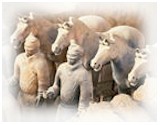| back  photo1 photo1
|
 The museum comprises three
buildings each spanning a pit. Pit 1, 2 and 3, respectively in order of discovery, are the
main formation with a total area of 22,780 square meters (Approx. 5 acres) and 1,000
life-size terra-cotta warriors, horses and chariots. The museum comprises three
buildings each spanning a pit. Pit 1, 2 and 3, respectively in order of discovery, are the
main formation with a total area of 22,780 square meters (Approx. 5 acres) and 1,000
life-size terra-cotta warriors, horses and chariots.Several hundred thousand workers
spent 36 years building the tomb, which the Emperor, at the age of 13, ordered to be built
shortly after he ascended the throne. It is said that workers and supervisors involved in
its design and construction were buried alive within the tomb. Some speculations say that
the Emperor was so superstitious and fearful that he had the necropolis built as a decoy
and was, in fact, buried somewhere else.
In the early spring of 1974, a number of peasants accidentally discovered some ancient
bronze weapons and pieces of broken terracotta armored warriors while sinking a well at
the northern foot of Mt. Lishan, 35 km from Xi'an, the famous cultural city in China's
history. No one ever expected that this accidental discovery would prove to be one of the
most significant modern archaeological finds, adding greater understanding to China's
history and at the same time unfolding a unique and majestic spectacle before the world:
the Terra-Cotta Warriors and Horses Museum, the underground army of terracotta warriors.
The museum is located 35 kilometers east of Xi'an. It's the most spectacular and important
place to visit owing to its 2,200-year old coloured terra-cotta army of more than 8,000
soldiers and horses buried to 'protect' the tomb of the first Qin Emperor.
(back) |
 The museum comprises three
buildings each spanning a pit. Pit 1, 2 and 3, respectively in order of discovery, are the
main formation with a total area of 22,780 square meters (Approx. 5 acres) and 1,000
life-size terra-cotta warriors, horses and chariots.
The museum comprises three
buildings each spanning a pit. Pit 1, 2 and 3, respectively in order of discovery, are the
main formation with a total area of 22,780 square meters (Approx. 5 acres) and 1,000
life-size terra-cotta warriors, horses and chariots.